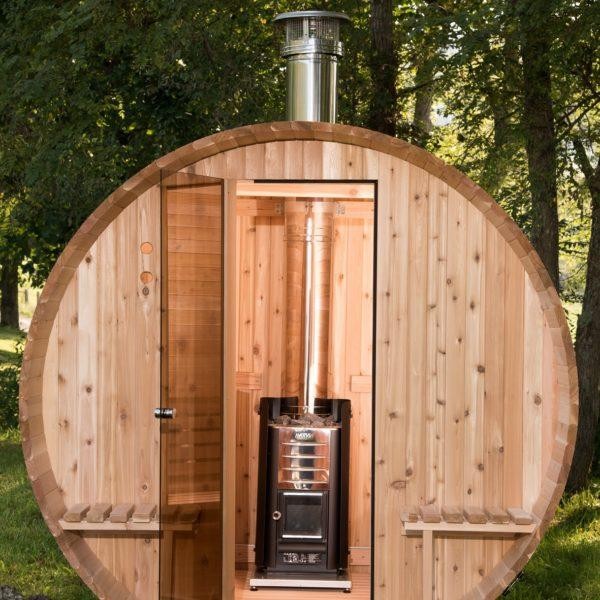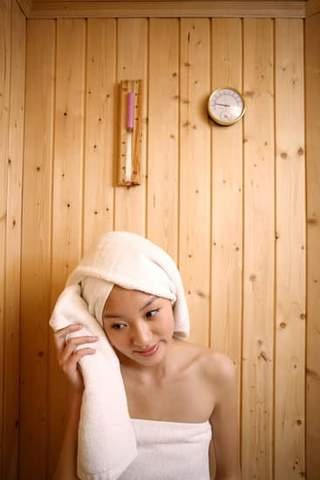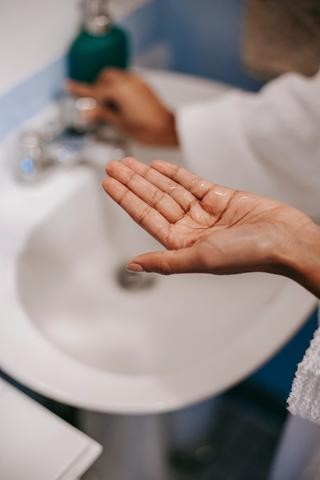7 SAUNA SAFETY TIPS
BEFORE ENTERING A WOOD-HEATED SAUNA
If you’re a beginner, you may wonder what can go wrong when using a sauna, or what precautions to take. This article will cover seven sauna safety tips to follow before entering a wood-heated sauna.

First, What is a Wood-Heated Sauna?
Wood-heated saunas use wood fire to generate heat, a leading characteristic of an authentic sauna. Wood-fire stoves heat the sauna stones, onto which water is then poured to generate steam.Outdoor traditional saunas that use wood-burning stoves such as the Harvia and HUUM stoves are a fan favorite with amazing health benefits such as detoxification, relaxation, stress reduction, muscle recovery, and better sleep.
Sauna Safety Tip #1: Avoid Drinking Alcohol before a Sauna Session

Drinking alcohol while sauna bathing can affect your body’s ability to maintain normal blood pressure. Your blood pressure is already low in a sauna and can even go lower under the influence of alcohol. It can also have a detrimental effect on the way your blood flows and heartbeats. Most sauna accidents, fainting, or injury usually result from alcohol ingestion. Below are other risks related to alcohol ingestion before or during a sauna session:
-
You might burn yourself as a result of the wrong equipment operation
-
Head contusions or heatstroke are possible in case you pass out
-
Dehydration: when you fall asleep in a sauna, it can even lead to sudden death
-
Falls, sprains, and slips are more likely to occur
Contrary to what most people believe, saunas are not a hangover cure. In this state, dehydration is more likely to happen, and you’ll feel worse as your symptoms are aggravated.
Sauna Safety Tip #2: Check Your Clothing
There are several clothing items you shouldn’t have while relaxing in your sauna. An individual is normally naked when sauna bathing, and there’s no need to carry around cell phones, jewelry, or iPods. Besides, metal objects heat up fast in saunas and can burn your skin. Therefore, for your safety, remove all gadgets and jewelry, like bracelets, rings, and earrings, before stepping into a sauna. Other clothing items to stay away from include:
Workout Attire: Avoid wearing any PVC-made clothing when sauna bathing. These clothes tend to melt when exposed to high sauna temperatures.
Dirty Clothing: The high sauna heat can cause invisible debris and dust in dirty clothes to loosen up. These particles can be inhaled and also expose your skin to acne breakouts.

What should you wear instead? It’s advisable to step in a sauna barefoot to prevent dirt accumulation. Use a towel for a wardrobe, and cotton shorts, a T-shirt, or a bathing suit are also suitable. Keep a towel on the benches to prevent sweat from staining the surface and for hygienic purposes.
Sauna Safety Tip #3: Rehydrate
Rehydrating is one of the most important sauna safety tips. Therefore, when planning your sauna session, ensure your body has enough water to bear the sweating. When sauna bathing, your body tends to lose a lot of nutrients and can lose up to 2% of your fluids. Follow these steps to prevent the dangers of fatigue and dehydration when sauna bathing:
-
Drink 16 to 20 ounces of water before your session, and bring a water bottle with you
-
Avoid sugary drinks such as coffee beverages, carbonated sodas, and sweet juices
-
Drink coconut water or sports drinks, which prepare your body for a sauna session. These drinks are full of electrolytes which replace what your body loses
Sauna Safety Tip #4: Avoid Overly Rich Foods
Ideally, you should take a good sauna steam and then catch some grub. Like sipping alcoholic drinks, high-calorie foods can lower your blood pressure. Avoid eating fish and meat if you’re planning to visit a sauna. These rich-protein foods can strain your kidneys and instead load your body with carbs.
During the high-temperature sauna session, the body works hard to remove toxins and other impurities through detoxification. So, when you enter a sauna with a full stomach, the food will stay sitting, intoxicating your body. The digestive system is inactive during the session, leading to risks such as nausea, headache, and food poisoning.
Sauna Safety Tip #5: Avoid Soap
Sauna sessions have numerous skin benefits. However, you’ll dry out your skin when you use soap showering before or during the session. Sauna experts advise bathing with soap a day before and rinsing off with herbal water before or during your sweet escape. It’s also important to exfoliate the skin.
Here are some herbal rinse ideas to get you started. Click this complete sauna herbal rinse recipes!
-
Lavender and Mint Water
-
Rosemary and Lemon Water
-
Chamomile and Calendula Water
-
Cucumber and Mint Water
-
Eucalyptus and Lemon Verbena Water

Just as you wouldn’t get into a hot tub or pool with dirty feet, clean your feet before a sauna session. Keep a tap or a bucket of water at the entrance or cleaning wipes to reduce the dirt amount tracking into the sauna. Although you can always vacuum or sweep your sauna floor, washing your feet first is a good precaution.
Sauna Safety Tip #6: Don’t Set the Temperature Too Hot
You should set the temperature of your sauna before getting in. This process is known as curing, and you should let the heat buildup for around 45 minutes to one hour for a traditional wood heated sauna.
However, it’s not advisable to withstand high sauna temperatures for extended periods. When your body becomes too hot, you tend to sweat more than you should. Too much sweating can lead to dehydration, and too much heat can damage your body.
Therefore, if you feel dizzy or uncomfortable, leave the sauna immediately. Start with a setting of 140 degrees Fahrenheit. If you want to experience more heat in the sauna, pour more water into the sauna stones for more humidity. Avoid increasing the temperature for the best results.
Sauna Safety Tip #7: Avoid Using Cosmetics or Perfume before a Sauna Session

SIGN UP. SAVE BIG.
Subscribe to be the first to know about our special monthly sauna sales, sent right to your inbox.
If you’re a regular user of makeup and perfume, try to avoid putting them on or using them before a sauna session. If possible, avoid using these products for at least a day before the session. Why is this? When relaxing in a sauna, your skin pores open up, but cosmetics and scented lotions or perfumes may enter the body, defeating the detoxification purpose.
When to Avoid Sauna Use Altogether
It’s important to consult a health professional or a doctor when using a wood-heated sauna. These saunas produce a lot of heat which is hard to control, especially if you’re a beginner. Below are some cases when you should consult a health practitioner or avoid using a sauna altogether:
Heart attack risk: If you’ve ever had a heart attack or are at an increased risk of having one, consult your doctor before a sauna session.
Low blood pressure: Individuals with low blood pressure, blood pressure problems, or heart attack risk should consult their doctor before using a sauna.
Avoid alcohol and other recreational drugs: Alcohol and drug consumption increases the risk of hypotension, dehydration, arrhythmia, and sudden death.
Dehydration risks: Individuals with certain health conditions, such as kidney disease, could be at a higher risk of dehydration.
Pregnancy: You should avoid sauna use throughout pregnancy.
Infections, fever, or sickness: If you’re not 100% healthy or have infectious conditions, you should avoid a sauna to avoid infecting others using the sauna. Avoid using a sauna as a means of treating your condition.
Essential Tips for Sauna Maintenance
It’s important to keep your sauna clean and well-maintained to ensure it works optimally and is hygienic for safe use. Fortunately, sauna maintenance is less costly and time-consuming than your pool or hot tub maintenance requirements. Therefore, you can keep your sauna working well for years with minimal maintenance between uses. Below are several tips on cleaning and maintaining your sauna before, during, and after use. Let’s dive in!
Air it Out
After a sauna session, wipe down the surfaces to eliminate the excess moisture. Afterward, leave the vents and door open to speed up the drying process and let in the fresh air. The entrance area of your sauna may experience wear and tear, so it’s advisable to regularly check for these signs.
For instance, if the sauna door doesn’t close properly, you should sand or plane the edges. You can also check the hinges or the latch. The vents in a wood-heated sauna allow fresh air into your sauna, helping regulate the humidity and heat levels. Therefore, always ensure they’re working properly.
Maintain the Wooden Interior
Maintaining your wooden sauna interior differs from other wooden surfaces like a siding or deck. This implies you cannot use stain, varnish, paint, or other sealants to treat your sauna interior walls. This is because the sauna wood has to be free to release and absorb moisture. Therefore, dip a brush in clean water to keep your sauna wood clean and wipe down the surfaces after use. If you need to clean surfaces, use mild dish detergent with clean water.
Avoid hard water, which can affect your sauna as it contains the “hard” calcium and magnesium salts that can build up in your sauna. You can remove any buildup with a gentle household cleaner, but use soft or distilled water without minerals and other impurities.
Your wooden interior look changes naturally over time and you can use a sanding disc to restore it. Also, ensure you cover the sauna rocks with plastic to prevent the accumulation of grit. You can vacuum the surface to get rid of any extra sand.
Conclusion
You’ll be sure to relieve tension effectively and work your way towards a healthier you by following these sauna safety tips.
Ensure you avoid alcoholic drinks and high-calorie foods for an effective sauna session. Also, avoid jewelry and tight-fitting clothes to ensure your maximum comfort for your wood-heated sauna session. Steer clear from perfume, cosmetics, and soaps for optimal sauna tranquility and health benefits.